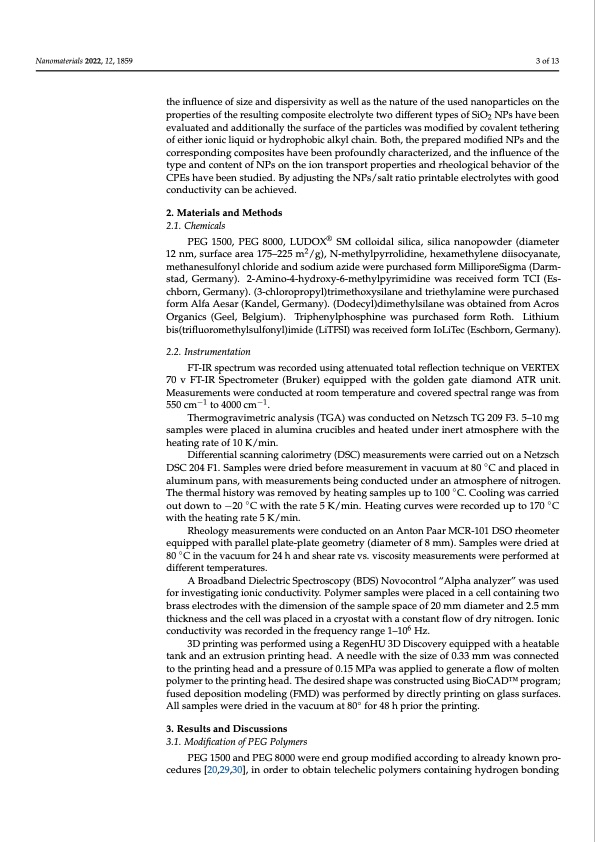
PDF Publication Title:
Text from PDF Page: 003
Nanomaterials 2022, 12, 1859 3 of 13 the influence of size and dispersivity as well as the nature of the used nanoparticles on the properties of the resulting composite electrolyte two different types of SiO2 NPs have been evaluated and additionally the surface of the particles was modified by covalent tethering of either ionic liquid or hydrophobic alkyl chain. Both, the prepared modified NPs and the corresponding composites have been profoundly characterized, and the influence of the type and content of NPs on the ion transport properties and rheological behavior of the CPEs have been studied. By adjusting the NPs/salt ratio printable electrolytes with good conductivity can be achieved. 2. Materials and Methods 2.1. Chemicals PEG 1500, PEG 8000, LUDOX® SM colloidal silica, silica nanopowder (diameter 12 nm, surface area 175–225 m2/g), N-methylpyrrolidine, hexamethylene diisocyanate, methanesulfonyl chloride and sodium azide were purchased form MilliporeSigma (Darm- stad, Germany). 2-Amino-4-hydroxy-6-methylpyrimidine was received form TCI (Es- chborn, Germany). (3-chloropropyl)trimethoxysilane and triethylamine were purchased form Alfa Aesar (Kandel, Germany). (Dodecyl)dimethylsilane was obtained from Acros Organics (Geel, Belgium). Triphenylphosphine was purchased form Roth. Lithium bis(trifluoromethylsulfonyl)imide (LiTFSI) was received form IoLiTec (Eschborn, Germany). 2.2. Instrumentation FT-IR spectrum was recorded using attenuated total reflection technique on VERTEX 70 v FT-IR Spectrometer (Bruker) equipped with the golden gate diamond ATR unit. Measurements were conducted at room temperature and covered spectral range was from 550 cm−1 to 4000 cm−1. Thermogravimetric analysis (TGA) was conducted on Netzsch TG 209 F3. 5–10 mg samples were placed in alumina crucibles and heated under inert atmosphere with the heating rate of 10 K/min. Differential scanning calorimetry (DSC) measurements were carried out on a Netzsch DSC 204 F1. Samples were dried before measurement in vacuum at 80 ◦C and placed in aluminum pans, with measurements being conducted under an atmosphere of nitrogen. The thermal history was removed by heating samples up to 100 ◦C. Cooling was carried out down to −20 ◦C with the rate 5 K/min. Heating curves were recorded up to 170 ◦C with the heating rate 5 K/min. Rheology measurements were conducted on an Anton Paar MCR-101 DSO rheometer equipped with parallel plate-plate geometry (diameter of 8 mm). Samples were dried at 80 ◦C in the vacuum for 24 h and shear rate vs. viscosity measurements were performed at different temperatures. A Broadband Dielectric Spectroscopy (BDS) Novocontrol “Alpha analyzer” was used for investigating ionic conductivity. Polymer samples were placed in a cell containing two brass electrodes with the dimension of the sample space of 20 mm diameter and 2.5 mm thickness and the cell was placed in a cryostat with a constant flow of dry nitrogen. Ionic conductivity was recorded in the frequency range 1–106 Hz. 3D printing was performed using a RegenHU 3D Discovery equipped with a heatable tank and an extrusion printing head. A needle with the size of 0.33 mm was connected to the printing head and a pressure of 0.15 MPa was applied to generate a flow of molten polymer to the printing head. The desired shape was constructed using BioCADTM program; fused deposition modeling (FMD) was performed by directly printing on glass surfaces. All samples were dried in the vacuum at 80◦ for 48 h prior the printing. 3. Results and Discussions 3.1. Modification of PEG Polymers PEG 1500 and PEG 8000 were end group modified according to already known pro- cedures [20,29,30], in order to obtain telechelic polymers containing hydrogen bondingPDF Image | 3D Printable Composite Polymer Electrolytes

PDF Search Title:
3D Printable Composite Polymer ElectrolytesOriginal File Name Searched:
nanomaterials-12-01859-v2.pdfDIY PDF Search: Google It | Yahoo | Bing
Product and Development Focus for Salgenx
Redox Flow Battery Technology: With the advent of the new USA tax credits for producing and selling batteries ($35/kW) we are focussing on a simple flow battery using shipping containers as the modular electrolyte storage units with tax credits up to $140,000 per system. Our main focus is on the salt battery. This battery can be used for both thermal and electrical storage applications. We call it the Cogeneration Battery or Cogen Battery. One project is converting salt (brine) based water conditioners to simultaneously produce power. In addition, there are many opportunities to extract Lithium from brine (salt lakes, groundwater, and producer water).Salt water or brine are huge sources for lithium. Most of the worlds lithium is acquired from a brine source. It's even in seawater in a low concentration. Brine is also a byproduct of huge powerplants, which can now use that as an electrolyte and a huge flow battery (which allows storage at the source).We welcome any business and equipment inquiries, as well as licensing our flow battery manufacturing.| CONTACT TEL: 608-238-6001 Email: greg@salgenx.com | RSS | AMP |